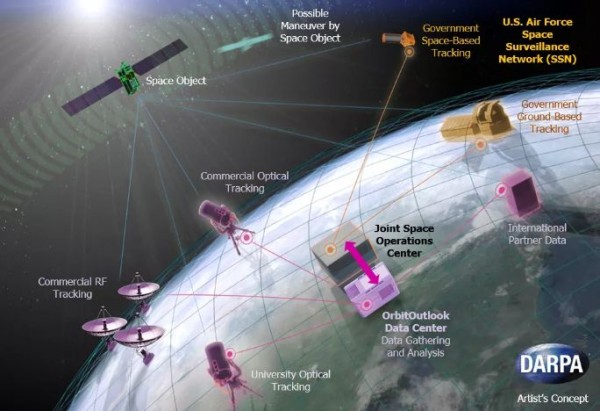DARPA's O2 Improved Space Surveillance Network Almost Complete
| Arthur Dominic Villasanta | | Jun 30, 2016 11:38 PM EDT |
(Photo : DARPA) DARPA's O2 system
The U.S. Defense Advanced Research Projects Agency (DARPA) said its program to better track the thousands of pieces of space debris or junk orbiting the planet (and presumably the "dark satellites" and anti-satellite weapons (ASATs) hidden among them) is making considerable progress.
Like Us on Facebook
DARPA's "OrbitalOutlook" (O2) program was launched in 2014 to improve the United States Space Surveillance Network (SSN) by adding more data more often from more diverse sources to increase space situational awareness to determine when satellites are at risk from colliding with space junk.
SSN is a worldwide network of 29 space surveillance sensors (radar and optical telescopes) that observes and catalogs space objects, including 1,200 operational satellites and over 500,000 pieces of man-made space debris orbiting Earth at 17,000 miles per hour.
DARPA recently reported its O2 network now comprises more than 100 sensors around the world, making it the largest space situational network ever assembled. O2 can also completely change how the U.S. military and the global space-debris-monitoring community collect and use space situational awareness data.
O2 consists of three elements: the inclusion of new telescopes and radar from diverse locations providing diverse data types; a central database for this newly extended network of telescopes and radar and a validation process to ensure the data is accurate. O2 also seeks to demonstrate the ability to rapidly include new instruments to alert for indications and warnings of space events.
O2 will combine government and civilian assets together to improve the space detection system, using optical telescopes and passive radio frequency telescopes from academic institutions and privately owned optical telescopes.
Another DARPA program, EchoView, will try to develop technology to harness commercial and civilian radar and passive RF telescopes, while the Low Inclined LEO Object detection program will deploy telescopes to Ascension Island in the South Atlantic Ocean for extra coverage of the equatorial orbits.
"By including new telescopes and radar facilities based in diverse locales, and by revolutionizing how we process different data types, we anticipate vast improvements in our tracking of potentially hazardous objects and our ability to efficiently avoid collisions in space," said Lt. Col. Jeremy Raley, DARPA program manager.
TagsDefense Advanced Research Projects Agency, DARPA, OrbitalOutlook program, space debris, space junk
©2015 Chinatopix All rights reserved. Do not reproduce without permission
EDITOR'S PICKS
-

Did the Trump administration just announce plans for a trade war with ‘hostile’ China and Russia?
-

US Senate passes Taiwan travel bill slammed by China
-

As Yan Sihong’s family grieves, here are other Chinese students who went missing abroad. Some have never been found
-

Beijing blasts Western critics who ‘smear China’ with the term sharp power
-

China Envoy Seeks to Defuse Tensions With U.S. as a Trade War Brews
-

Singapore's Deputy PM Provides Bitcoin Vote of Confidence Amid China's Blanket Bans
-

China warns investors over risks in overseas virtual currency trading
-

Chinese government most trustworthy: survey
-

Kashima Antlers On Course For Back-To-Back Titles
MOST POPULAR
LATEST NEWS
Zhou Yongkang: China's Former Security Chief Sentenced to Life in Prison

China's former Chief of the Ministry of Public Security, Zhou Yongkang, has been given a life sentence after he was found guilty of abusing his office, bribery and deliberately ... Full Article
TRENDING STORY

China Pork Prices Expected to Stabilize As The Supplies Recover

Elephone P9000 Smartphone is now on Sale on Amazon India

There's a Big Chance Cliffhangers Won't Still Be Resolved When Grey's Anatomy Season 13 Returns

Supreme Court Ruled on Samsung vs Apple Dispute for Patent Infringement

Microsoft Surface Pro 5 Rumors and Release Date: What is the Latest?













